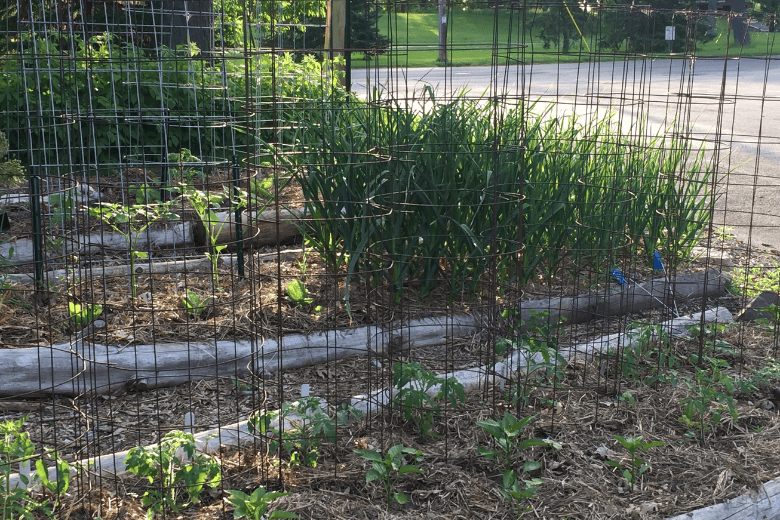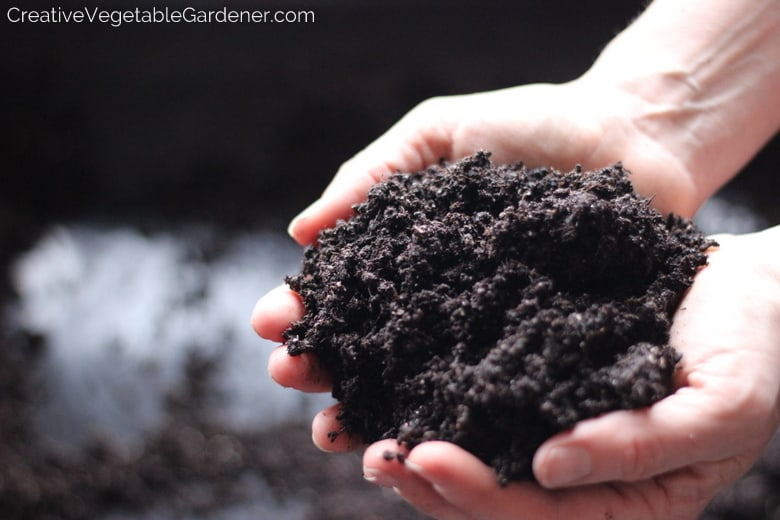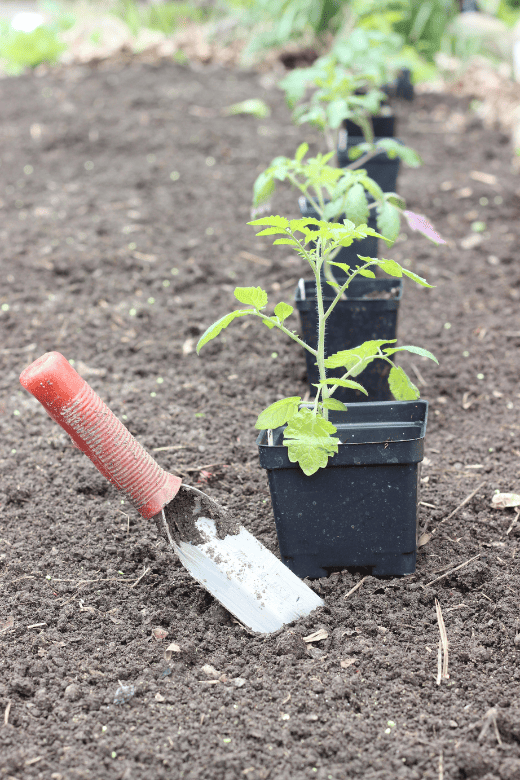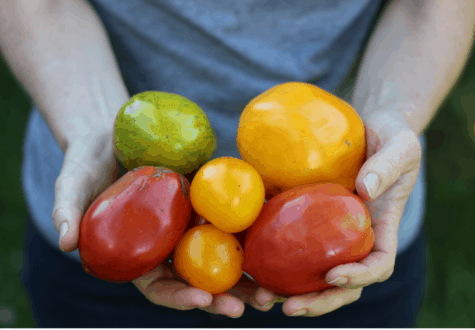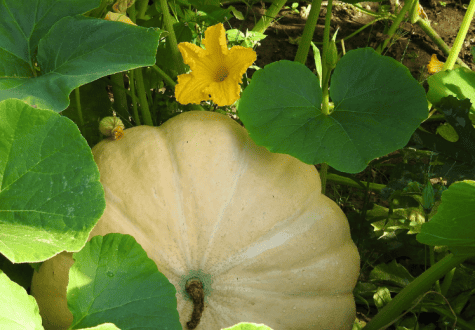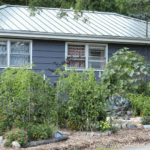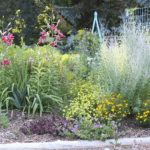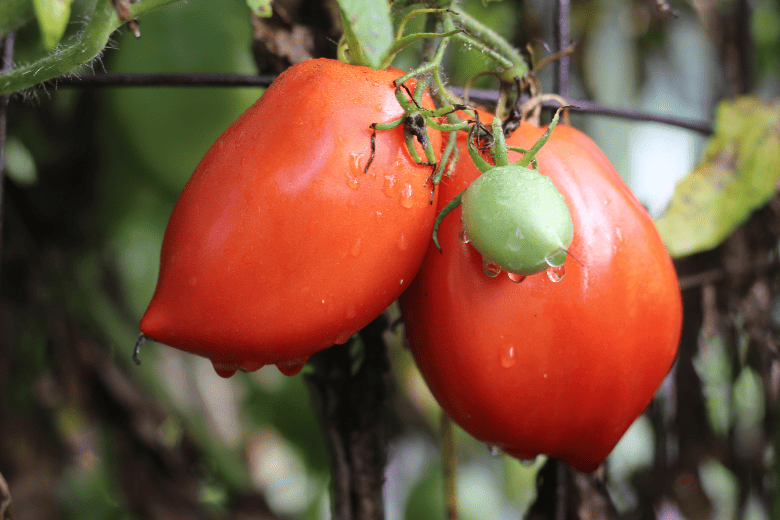
When I used to garden in my local community garden, Memorial Day often felt like the official start of the gardening season. The garden would be bustling with excited gardeners carrying their recent farmers market purchases of tomatoes and peppers. Every tool and wheelbarrow from the shed was put to use. A popular topic of conversation was when to transplant tomatoes.
Here’s a little story about a mistake I made one year. The average last frost date in southern WI where I garden is around the first week of May. My husband and I made plans to go camping on Memorial day weekend, and wanted to get the plants in the ground before we left. Because it was past our average last frost, it seemed like a low risk gardening decision.
That week the forecast changed from cool to cold at night and a chance of frost was predicted for Memorial Day Weekend. What!? It was too late, the plants were in the ground and the camping tubs packed. The only option before leaving town was to try to protect the plants with row cover.
But, alas there was indeed a killing frost and I returned from my camping trip to a garden full of loss and sorrow. Most of my pepper plants were dead and the tomatoes didn’t look much better.
I don’t share this story to scare you, but rather to encourage you to consider when the best time to plant tomatoes is for your garden zone. In this article, we dig deeper into when to transplant tomatoes and explore how to best care for the plants once they’re in the ground so you’re guaranteed to be harvesting baskets full of colorful fruit all season long.
Timing Matters: When to Transplant Tomatoes
There are four factors to consider when you’re deciding when to transplant tomatoes in the spring.
Tomatoes are not frost resistant!
From their thin tissue paper leaves to the delicate water filled stems, there is no part of this plant that can tolerate below freezing temps.
This means it’s critical to be aware of your average last frost date. If you don’t know what it is, go to the website plantmaps.com and enter in your zip code.
It will pull up lots of information about your area, including your average last frost. It lists a date range, so if you want to be on the safe side you can pick a date at the end of the range for your last frost.
Keep in mind that the actual day of the last frost can vary widely from year to year, especially with changing climate conditions. As we learned about, my average last frost is usually around Mother’s Day, we have had frosts as late as Memorial Day Weekend.
If you’re unsure of when to plant each vegetable in your garden, I recommend reading this article about creating your own custom planting schedule.
Tomatoes grow best in warm air and soil temperatures.
Personally, I don’t think you gain much by dropping tomato plants in the ground as early as possible. I’ve noticed that they’re more likely to get stressed by cooler weather. They also don’t grow very much during the early spring months.
If you pay attention in your garden, you’ll see that tomato plant growth really starts taking off when the warmer temperatures of summer arrive.
You must harden off your tomato plants before putting them in the garden.
Hardening off your tomato plants is the process of adjusting your young, delicate indoor loving plants to the windy, wet and direct sunlight conditions that they will experience when transplanted into the garden.
You absolutely cannot take a plant that was growing inside your house and plant it right into the garden. It will likely die!
If you started your seeds indoors and the weather is staying consistently above 45 degrees during the day, it’s time to start hardening off your tomatoes. I talk more about this process in #10 of my article on common mistakes of seed starting.
If your purchased your plants from a reputable grower your plants should already be hardened off.
Keep an eye on the 10 day forecast.
Do not plant your tomatoes (or other frost sensitive plants) if there is any chance of the nighttime temperatures falling close to 32 degrees F. It’s not worth the risk of losing your plants and it will require a lot of extra work to try to keep them alive during a cold snap.
Staying on top of the forecast will help you determine when to transplant tomatoes.
Tomato Soil Requirements
The health of your soil is one of the main factors that affect how successful your garden will be each season. In fact, you should be spending time and effort to build the best soil for a vegetable garden.
When your soil contains all of the nutrients the plants need they’ll grow larger and be more productive, the fruit and vegetables they produce will be a higher quality, and the plants will better resist disease and pest pressure.
At the very least, I suggest adding an organic garden fertilizer to your beds before planting all seeds and plants. This practice has made a huge difference in the quality of my garden harvests over the years.
Tomatoes are heavy feeders, so preparing your beds before planting will help guarantee that there will be enough fertility to keep your plants growing and fruiting through the end of summer.
What Not to Plant with Tomatoes
Now that you know when to transplant tomatoes, have your plants hardened off and your garden beds prepped, it’s time to plan out where you will be planting tomatoes in your garden beds.
Tomato fruits come in all shapes, sizes and colors. Tomato plants come in two main types of genetics, determinate and indeterminate.
Determinate tomato plants, known as bush tomatoes, grow to a shorter stature while indeterminate plants, known as vining tomatoes, will keep growing until the last frost. Some of my indeterminate plants have grown to over 8′ tall by the end of the season!
If you live in the northern hemisphere, planting your indeterminate tomatoes on the south side of your garden can block the light from other sun-loving vegetables. This is like going to an outdoor concert and someone super-tall decides to stake their spot directly in front you. With better planning, the tall person would be in the back row with some binoculars. (No offense to tall people.)
In my garden, I try to plant my indeterminate tomatoes in areas where they won’t shade other shorter plants behind them as they grow throughout the season. If you have a small garden, this could look like planting the tomatoes along the north side of a garden bed and other shorter vegetables in front of them.
Because determinate tomatoes are much shorter plants, I don’t worry as much about where to plant them. Read the descriptions on the seed packets and plant your beds with determinate varieties on the south side of the garden and indeterminate varieties to the north, and everyone wins.
How to Plant Tomatoes in the Ground
Reading through this article has hopefully explained when to transplant tomatoes. Your plants are hardened off, your beds are picked out and you’re ready to plant.
I space my tomatoes 18” between plants, with two rows in my 4′ wide garden beds. This tighter spacing allows me to squeeze an extra row in each raised bed.
If I was to space my rows every 4’ that would only allow one row per bed and if I planted with 2’ spacing between plants I would quickly fill my garden beds with mostly tomatoes.
In order to accommodate 18” spacing I’ve made my DIY tomato cages a on the narrow side to make room for an extra row in each bed.
Now that your have your layout determined it’s time to plant:
Step 1: Dig a hole with your trowel and pour a bunch of water in to soak the area. During this step I always add a handful of organic garden fertilizer.
Step 2: Break the root ball of the plant gently to encourage the roots to start to move outwards, not around in a circle like they did in the pot.
Step 3: Tuck the plant into the hole. No need to water again right now, the root ball is soaked from the water you poured into the planting hole.
Step 4: Use a measuring tape to figure out where to plant the next seedling.
You can read more and see lots of photos about how I plant seedlings.
How Far Apart to Plant Cherry Tomatoes
Cherry tomatoes are an indeterminate variety that can quickly grow to an unmanageable state. They can easily outgrow an 8’ high trellis over the growing season in southern Wisconsin.
Over the years I’ve stopped growing them in cages and have taken to growing my them on cattle panel trellises. I love the look of the plants growing over the arches and the fruit hanging below the foliage, making for easier harvesting.
In the photo above, I’ve planted one cherry tomato at the foot of a trellis because there’s a clematis next to it. Usually I plant two cherry tomatoes on each side of the trellis, keeping to my 18″ spacing between plants.
Tomato Growing Tips For a Bountiful Harvest
Prevent Tomato Disease
Unfortunately, in many locations there’s a long list of diseases that attack, and often kill, our beloved plants.
Like most things in life there is no one sure fire way to creating healthy living conditions, be that in people or plants. Preventing disease in tomato plants requires a multifaceted approach to creating and maintaining healthy conditions for your plants.
Most of the diseases are fungal in nature and are often hard for the untrained eye to tell apart. The good news is there are some things you can do in your garden to decrease the negative impact these diseases have on your summer harvests.
Learn about best practices for preventing tomato disease each season.
Prune and Cage or Trellis
Pruning and using tomato cages are two active ways of preventing disease in your plants. Pruning your tomatoes can help provide more airflow and sunlight to reach the plants evenly, helping to reduce disease and improve ripening of fruit. Read about the process of pruning indeterminate tomatoes.
The use of tomato cages provide the structure and support that tomato plants need to avoid contact with the ground where foliar disease can start. And caging or trellising your tomatoes will make harvesting easier. Make your own DIY tomato cage. Cattle panel trellis are another fun way to keep your tomatoes growing upright.
Water the Right Way
Water is another obvious need of tomato plants. Tomato plants do best in warm dry weather, too hot at night and they can drop setting fruit from the plant and too wet and the fruit will crack on the vine.
Learning to water your vegetable garden the right way is an important gardening skill and when done well your plants will be healthier with fruit that is better tasting and looking. Tomatoes do not like to be overwatered!
I use a rain gauge in my garden and this allows me to track how much water my garden needs, saving me time in the garden by preventing overwatering.
Mulch
Mulch is by far the simplest and most effective tool in my garden. Mulch helps conserve soil moisture, prevents weed seeds from sprouting, and protects the soil from compacting after heavy rain events. Mulching my garden saves me time and very slowly improves soil fertility as it breaks down.
Tomatoes benefit from mulch because it can help slow down the spread of soil borne diseases which can splash up onto to plant during rainstorms.
Mulch is amazing! Read more about vegetable garden mulch.
What to Plant After Tomatoes
In the process of learning about growing vegetables I spent a season working on a five acre organic vegetable farm. Often the scale of the operation couldn’t be practiced in my small home garden, but the concepts still applied.
Rotating what plants are grown in the same garden bed year to year is one effective way of preventing the spread of disease and pests. On the farm they used a seven year rotation of plant families. This means not only did they not plant tomatoes in the same space the next year, they also avoided planting other members of the Solanaceae family, peppers, eggplant, potatoes and ground cherries.
As a home gardener, I have a postage stamp sized plot compared to that farm. When rotating my tomatoes I look at the past couple years of garden maps in my journal and look for the beds that haven’t grown tomatoes, peppers, or eggplant in the past few years and plant accordingly.
Depending on what size garden you have, just do the best you can and don’t plant the same thing in the same place year after year.
When transplanting tomatoes every gardener anticipates the first ripe tomato that gets plucked from the vine. I know that my taste buds look forward to one of summer’s signature moments.
By taking my time throughout the process of growing tomatoes I will have a more reliable, larger and tastier harvest. Hopefully, this Memorial Day Weekend provides lovely weather and gardening fun that inspires me to feel confident that it’s exactly when to transplant tomatoes!

